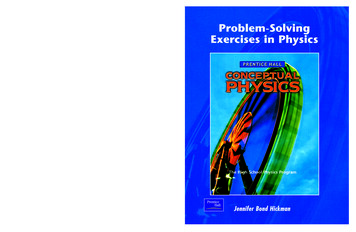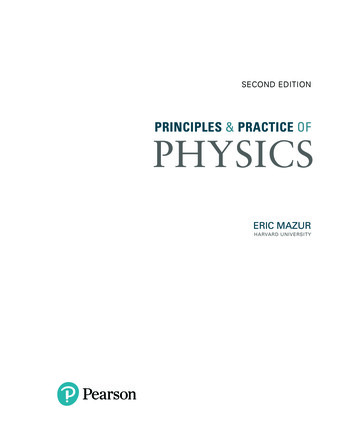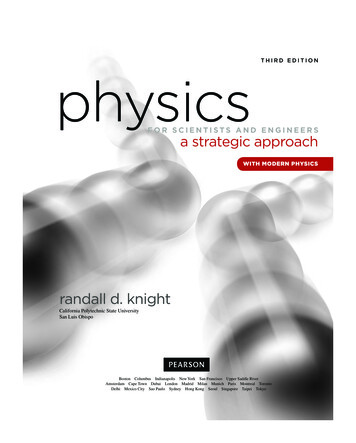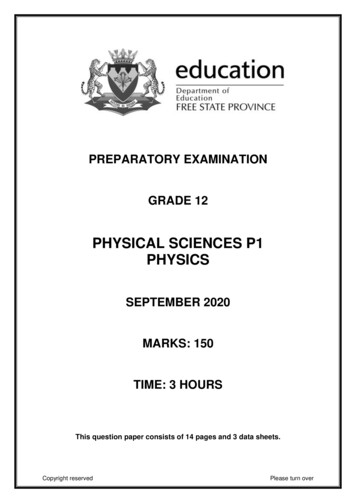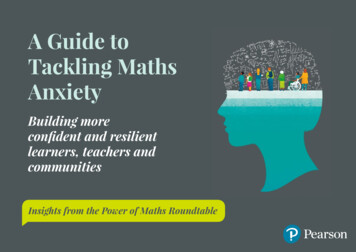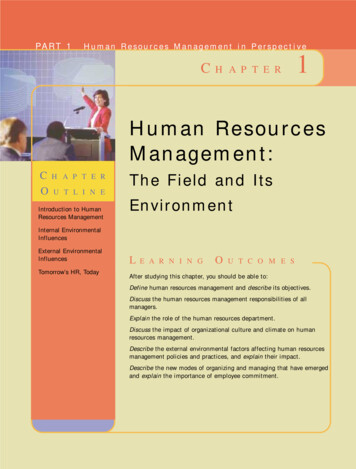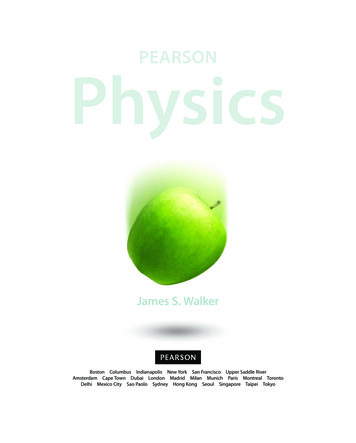
Transcription
PearsonPhysicsJames S. WalkerBoston Columbus Indianapolis New York San Francisco Upper Saddle RiverAmsterdam Cape Town Dubai London Madrid Milan Munich Paris Montreal TorontoDelhi Mexico City Sao Paolo Sydney Hong Kong Seoul Singapore Taipei TokyoWALK1156 01 FM pp00i-xxi.indd 11/18/13 11:11 AM
Credits appear on pages R93 and R94, which constitute an extension of this copyright page.Copyright 2014 Pearson Education, Inc., or its affiliates. All Rights Reserved. Printed in the United States of America. Thispublication is protected by copyright, and permission should be obtained from the publisher prior to any prohibited reproduction,storage in a retrieval system, or transmission in any form or by any means, electronic, mechanical, photocopying, recording, orlikewise. For information regarding permissions, write to Rights Management & Contracts, Pearson Education, Inc., One Lake Street,Upper Saddle River, New Jersey 07458.Pearson and MasteringPhysics are trademarks, in the U.S. and/or other countries, of Pearson Education, Inc., or its affiliates.ExamView is a registered trademark of eInstruction Corporation.ISBN-13: 978-0-13-137115-6ISBN-10: 0-13-137115-0PearsonSchool.comWALK1156 01 FM pp00i-xxi.indd 21 2 3 4 5 6 7 8 9 10 CRK 18 17 16 15 14 131/18/13 11:11 AM
James Walker obtained his Ph.D. in theoretical physicsAbout the Authorfrom the University of Washington in 1978. He subsequently served as apost-doc at the University of Pennsylvania, the Massachusetts Instituteof Technology, and the University of California at San Diego beforejoining the physics faculty at Washington State University in 1983.Professor Walker’s research interests include statistical mechanics, criticalphenomena, and chaos. His many publications on the application ofrenormalization group theory to systems ranging from absorbedmonolayers to binary-fluid mixtures have appeared in Physical Review,Physical Review Letters, Physica, and a host of other publications. He hasalso participated in observations on the summit of Mauna Kea, lookingfor evidence of extrasolar planets.Jim Walker likes to work with students at all levels, from judgingelementary school science fairs to writing research papers with graduatestudents, and has taught introductory physics for many years. Hisenjoyment of this course and his empathy for students have earned hima reputation as an innovative, enthusiastic, and effective teacher. Jim’seducational publications include “Reappearing Phases” (ScientificAmerican, May 1987) as well as articles in the American Journal of Physicsand The Physics Teacher. In recognition of his contributions to theteaching of physics at Washington State University, Jim was namedBoeing Distinguished Professor of Science and Mathematics Educationfor 2001–2003.When he is not writing, conducting research, teaching, ordeveloping new classroom demonstrations and pedagogical materials,Jim enjoys amateur astronomy, eclipse chasing, bird and dragonflywatching, photography, juggling, unicyling, boogie boarding, andkayaking. Jim is also an avid jazz pianist and organist. He has served asballpark organist for a number of Class A minor league baseball teams,including the Bellingham Mariners, an affiliate of the Seattle Mariners,and the Salem-Keizer Volcanoes, an affiliate of the San Francisco Giants.He can play “Take Me Out to the Ball Game” in his sleep.iiiWALK1156 01 FM pp00i-xxi.indd 31/18/13 11:11 AM
ReviewersHakan ArmaganDavid HeesPamela PerryMichael BlairThomas HendersonSusan PolandCharles HibbardGloria RecheLana HoodDiane RiendeauJanie HornBrian ShockRobert JuranitchLinda SingleyBurke High SchoolOmaha, NebraskaTheodore Roosevelt HighSchoolDes Moines, IndianaMichael BrickellSomerset High SchoolGalloway, OhioMark BuesingLibertyville High SchoolLibertyville, IllinoisBeverly CannonHighland Park High SchoolDallas, TexasChris ChiaverinaNew Trier High SchoolWinnetka, IllinoisAnthony CutaiaWhite Plains High SchoolWhite Plains, New YorkJohn DellThomas Jefferson High Schoolfor Science and TechnologyAlexandria, VirginiaJim DillonMadison High SchoolMansfield, OhioEleanor DorsoBrentwood High SchoolBrentwood, New YorkStan EisensteinCentennial High SchoolEllicott City, MarylandPaul GathrightWillis High SchoolWillis, TexasOommen GeorgeSan Jacinto College CentralPasadena, TexasJack GiannattasioA. L. Johnson High SchoolClark, New JerseyBernard GilroyThe Hun School of PrincetonPrinceton, New JerseyMarla GloverRossville High SchoolRossville, IndianaLeon M. Goldstein High SchoolBrooklyn, New YorkGlenbrook South High SchoolGlenview, IllinoisLowell High SchoolSan Francisco, CaliforniaRobert E. Lee HighTyler, TexasCleveland High SchoolCleveland, TexasUniversity School of MilwaukeeMilwaukee, WisconsinJackie KellyEl Toro High SchoolLake Forest, CaliforniaBoris KorsunskyWeston High SchoolWeston, MassachusettsJames MaloyBethlehem Center High SchoolFredericktown, PennsylvaniaDavid MartinMasuk High SchoolMonroe, ConnecticutJohn McCannWaynesboro Area Senior HighWaynesboro, PennsylvaniaTheodore NeillSenior High SchoolHarmony, PennsylvaniaMary NorrisStephenville High SchoolStephenville, TexasMatthew OhlsonLewiston High SchoolLewiston, MaineDysart High SchoolEl Mirage, ArizonaSuccess AcademyHouston, TexasDeerfield High SchoolDeerfield, IllinoisPowhatan High SchoolPowhatan, VirginiaGreencastle-Antrim HighSchoolGreencastle, PennsylvaniaLarry StookeyAntigo High SchoolAntigo, WisconsinMartin TeachworthLa Jolla High SchoolLa Jolla, CaliforniaRichard ThompsonSomerset High SchoolSomerset, WisconsinBlythe TippingSylvania Southview High SchoolSylvania, OhioConnie WellsPembroke Hill SchoolKansas City, KansasJeff WetherholdParkland High SchoolAllentown, PennsylvaniaMatt WilsonHolly High SchoolHolly, MichiganGreen Local SchoolsGreen, OhioSteve OppmanWest High SchoolOshkosh, WisconsinChris PeoplesSunny Hills High SchoolFullerton, CaliforniaivWALK1156 01 FM pp00i-xxi.indd 41/18/13 11:11 AMWALK115
A New Force inPhysicsPearson Physics offers a new path to mastery—a “concepts first ” approach that supportsa superior, step-by-step problem solving process.In your new program, you’ll find: Example problems that build reasoning and problem-solving skills. Relevant connections that tie abstract concepts to everyday experiences and modern technologies. Rich lab explorations and study support that allow students to practice and reinforce essential skills. Cutting-edge technology that offers multiple options for interacting with—and mastering—the content.The following pages showcase several key elements of Pearson Physics that will lead students to success.The Big Ideaemphasizes the centralconcept of the chapter.Key Questions ineach lesson call outimportant concepts andhighlight their answersin the discussion.vWALK1156 01 wlkthr.indd 3WALK1156 01 FM pp00i-xxi.indd 51/10/13 1:56 PM1/18/13 11:11 AM
Leading by ExampleEvery class contains a unique and diverse groupof students. Pearson Physics supports eachstudent’s unique learning style, offering allstudents a path to success. A key element of thisapproach is the program’s use of four distinctExample types, each with a particular purpose.Quick Examplesoffer simple andconcise solutions thatmodel how newlyintroduced equationsand units are used.Conceptual Examples pose athought-provoking questionand then explain the logicalreasoning and physics conceptsneeded to answer it.Active Examples ask studentsto take an active role in solvingthe problem by thinkingthrough the logic describedon the left and verifying theiranswers on the right.Guided Examples present avisual model of the physicalsituation and outline the keyconcepts that apply to it beforeproceeding to the detailedstep-by-step solution.viWALK1156 01 wlkthr.indd 4WALK1156 01 FM pp00i-xxi.indd 61/10/13 1:56 PM1/18/13 11:11 AMWALK1156 0
10/13 1:56 PMRelevantConnectionsPearson Physics emphasizes the factthat physics applies to everything inyour world, connectingideas and concepts toeveryday experience.Physics & You features throughoutthe book explain the physics behindinteresting technologies, the impactof technology on society, and therole of physics in various careers.Physics & You: Technology passagesin the discussion explain how variousmodern technologies make use ofthe physics concepts just learned.viiWALK1156 01 wlkthr.indd 5WALK1156 01 FM pp00i-xxi.indd 71/10/13 1:56 PM1/18/13 11:11 AM
In-text Labs and Study ToolsPearson Physics provides hands-on lab explorations in the text itself and through aseparate Lab Manual. Extra study support features appear throughout the chapterswhen students need them most.Short, simple, and interestingInquiry Labs open eachchapter and offer a chance toexplore some of the chapter’sfundamental concepts.Physics Labs are traditionalsingle-page lab activities thatuse easy to obtain materials.Math HELP boxes inexample problems guidestudents to extra mathsupport material containedin the Math Review chapter.Connecting Ideas featuresthe important concepts fromlesson to lesson and chapterto chapter, helping studentssee the bigger picture.viiiWALK1156 01 wlkthr.indd 6WALK1156 01 FM pp00i-xxi.indd 81/10/13 1:56 PM1/18/13 11:11 AMWALK1156 0
10/13 1:56 PMThe Mastering platform is the most effective and widely used online homework,tutorial, and assessment system for physics. Students interact with self-paced tutorials that focus on course objectives,provide individualized coaching, and respond to their progress. Instructors use the Mastering system to maximize class time with easy-to-assign, customizable, and automatically graded assessments that motivatestudents to learn outside of class and arrive prepared forlecture and lab.Prelecture QuestionsAssignable Prelecture Concept Questionsencourage students to read the textbook sothey’re more engaged in class.Gradebook DiagnosticsThe Gradebook Diagnostics screen providesinstructors with weekly diagnostics. With asingle click, charts identify the most difficultproblems, vulnerable students, and gradedistribution.Tutorials with Hintsand FeedbackMastering’s easy-to-assign tutorials providestudents with individualized coaching. Hints and Feedback offer “scaffolded”instruction similar to what studentswould experience in an after-schoolstudy session. Hints often provide problem-solvingstrategies or break the main probleminto simpler exercises. Wrong-answer-specific feedback givesstudents exactly the help they needby addressing their particular mistakewithout giving away the answer.ixWALK1156 01 wlkthr.indd 7WALK1156 01 FM pp00i-xxi.indd 91/10/13 1:56 PM1/18/13 11:11 AM
Contents4.3 Relative Motion 1274.4 Projectile Motion 1315 Newton’s Laws of Motion150Big Idea All motion is governed by Newton’s laws.5.15.25.3Newton’s Laws of Motion 151Applying Newton’s Laws 161Friction 1706 Work and Energy188Big Idea Energy can change from one form1 Introduction to Physicsto another, but the total amount ofenergy in the universe stays the same.26.16.26.36.4Big Idea Physics applies to everything.1.11.21.31.41.5Physics and the Scientific MethodPhysics and Society 10Units and Dimensions 15Basic Math for Physics 23Problem Solving in Physics 3332 Introduction to Motion7 Linear Momentumand Collisions 228Big Idea Momentum is conserved in all collisions,42as long as external forces do not act.Big Idea Motion can be represented7.17.27.37.4by a position-time graph.2.12.22.32.4Describing Motion 43Speed and Velocity 48Position-Time Graphs 54Equation of Motion 583 Acceleration and AcceleratedMotion 72Big Idea All objects in free fall move withthe same constant acceleration.3.13.23.33.4Acceleration 73Motion with Constant Acceleration 82Position-Time Graphs for Constant AccelerationFree Fall 97924 Motion in Two Dimensions 112Big Idea The horizontal and vertical motions ofan object are independent of one another.4.1 Vectors in Physics 1134.2 Adding and Subtracting Vectors 121Work 189Work and Energy 197Conservation of Energy 206Power 211Momentum 229Impulse 234Conservation of Momentum 242Collisions 2488 Rotational Motion andEquilibrium 266Big Idea Forces can produce torques, andtorques can produce rotation.8.18.28.38.4Describing Angular Motion 267Rolling Motion and the Moment of InertiaTorque 281Static Equilibrium 2902769 Gravity and CircularMotion 306Big Idea Gravity acts on everything in the universe.9.19.29.39.4Newton’s Law of Universal Gravity 307Applications of Gravity 313Circular Motion 320Planetary Motion and Orbits 327x ContentsWALK1156 01 FM pp00i-xxi.indd 101/18/13 11:11 AM
10 Temperature and Heat342Big Idea Heat is a form of energy that is trans-ferred because of temperature differences.10.110.210.310.4Temperature, Energy, and Heat 343Thermal Expansion and Energy TransferHeat Capacity 358Phase Changes and Latent Heat 36611 Thermodynamics15.2 Color and the Electromagnetic Spectrum 53615.3 Polarization and Scattering of Light 54516 Reflection and Mirrors564Big Idea Mirrors are particularly good at reflecting350light; a mirror’s shape determines the size,location, and orientation of the reflected image.16.1 The Reflection of Light 56516.2 Plane Mirrors 57016.3 Curved Mirrors 575384Big Idea Energy conservation appliesto thermal energy and heat.11.1 The First Law of Thermodynamics 38511.2 Thermal Processes 39311.3 The Second and Third Laws ofThermodynamics40012 Gases, Liquids, and Solids414Big Idea Fluids flow and change shape easily,whereas solids maintain a definiteshape unless acted on by a force.12.112.212.312.4Gases 415Fluids at Rest 424Fluids in Motion 435Solids 44013 Oscillations and Waves17 Refraction and LensesBig Idea Lenses take advantage of refrac452Big Idea Waves are traveling oscillationsthat carry energy.13.113.213.313.4Oscillations and Periodic Motion 453The Pendulum 462Waves and Wave Properties 470Interacting Waves 47614 Soundtraveling wave of compressions andexpansions.Sound Waves and Beats 493Standing Sound Waves 501The Doppler Effect 507Human Perception of Sound 513effects of supe
Pearson Physics provides hands-on lab explorations in the text itself and through a separate Lab Manual. Extra study support features appear throughout the chapters when students need them most. Physics Labs are traditional single-page lab activities that use easy to obtain materials. Math HELP boxes in example problems guide students to extra math

